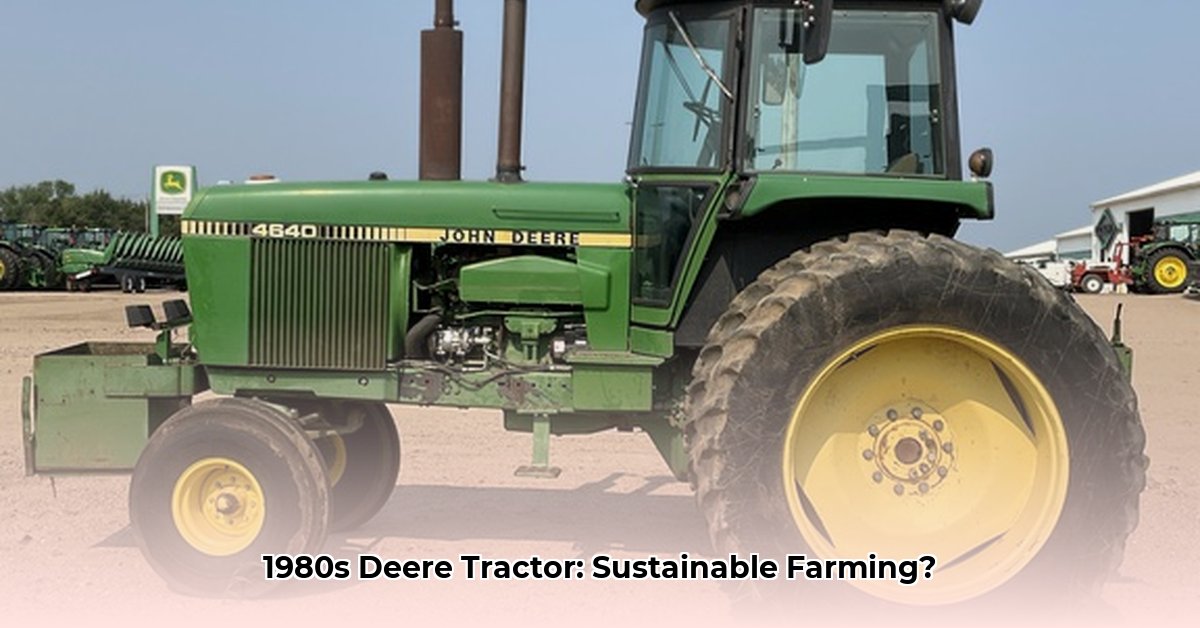
The Green Giant of the Eighties
Imagine the late afternoon sun casting long shadows across a vast Iowa cornfield in 1980. The rhythmic chug of a John Deere tractor, a powerful machine cutting a swathe through the ripening crop, fills the air. This wasn't just a tractor; it was a symbol of agricultural progress, a testament to the mechanization revolution reshaping farming. This article explores the 1980 John Deere, its impact on agriculture, and the evolving conversation around sustainable farming practices. We'll examine the technological advancements of the time, the environmental implications of increased mechanization, and the innovations driving a more sustainable future. For more details on specific models, see this helpful resource: John Deere Tractor Models.
A Technological Marvel: The 1980 John Deere
The 1980 John Deere models, like the 4440, represented a significant leap forward. Compared to earlier models, they offered increased horsepower and improved fuel efficiency, though precise figures are difficult to obtain due to variations in models and operating conditions. This meant farmers could cultivate larger areas faster, leading to higher crop yields. This boost in productivity was crucial in meeting the demands of a growing global population. The increased efficiency also meant that fewer laborers were needed, significantly impacting the social structure of rural communities. But was this progress without cost?
The Double-Edged Plow: Progress and its Environmental Footprint
While the increased efficiency of the 1980s John Deere tractors led to higher yields and reduced the amount of land needed per unit of food, it also came with a substantial environmental cost. The larger, more powerful tractors consumed significantly more fossil fuels than their predecessors, resulting in a larger carbon footprint and contributing to greenhouse gas emissions. This increased reliance on fossil fuels remains a point of concern in modern discussions of sustainable agriculture. Furthermore, the mechanization often went hand-in-hand with intensive farming practices like monoculture and heavy use of chemical fertilizers and pesticides, raising questions about the long-term impacts on soil health, biodiversity, and overall ecosystem balance. Did the short-term gains in productivity outweigh the long-term environmental consequences? This is a question that continues to be debated among agricultural experts and environmental scientists.
Farming's Future: Sustainable Practices and Technological Innovation
The legacy of the 1980 John Deere tractor underscores the need for a holistic approach to agriculture. Sustainable farming requires a multifaceted strategy focusing on:
- Technological Advancements: The development of electric tractors and those powered by alternative fuels is crucial to reducing greenhouse gas emissions. The transition to cleaner energy sources is paramount for a sustainable future.
- Precision Agriculture: Technologies like GPS-guided machinery and sensors allow for precise application of resources like fertilizer, water, and pesticides, minimizing waste and environmental impact. This targeted approach leads to less chemical runoff and more efficient resource use.
- Sustainable Farming Techniques: Practices like crop rotation, cover cropping, and no-till farming improve soil health, reduce erosion, and minimize the need for chemical inputs. These time-tested methods contribute to long-term soil fertility.
- Full Lifecycle Consideration: A complete assessment of a tractor's entire lifespan—from manufacturing to disposal—is necessary. Sustainable materials, efficient manufacturing processes, and robust recycling programs are all essential components of a circular economy.
The Road Ahead: Balancing Progress and Environmental Responsibility
The 1980 John Deere tractor, while a symbol of agricultural progress, inadvertently highlighted the need for a more sustainable future. The challenge lies in balancing the need for increased food production with the imperative to protect the environment. This requires a multi-pronged approach encompassing technological innovation, responsible farming practices, and comprehensive life-cycle assessments to fully understand the environmental footprint of different approaches. Continued research and collaboration are crucial to ensure a future where we can feed a growing population while safeguarding the planet for future generations.
Key Takeaways:
- The mechanization of agriculture, while increasing efficiency, has brought about environmental challenges related to greenhouse gas emissions, soil degradation, and reliance on fossil fuels.
- The transition to sustainable agricultural practices requires a holistic approach, encompassing technological innovations, efficient resource management, and environmentally conscious farming techniques.
- Further research is needed to fully assess the environmental benefits and potential trade-offs of various technologies and practices.